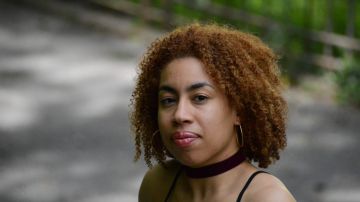Gallery Gurls Is Creating a Place for Women of Color in the Art World
Jasmin Hernandez is on a mission to bring women of color to the forefront of the art world

Photo: David Sarmiento/Jasmin Hernandez
Jasmin Hernandez is on a mission to bring women of color to the forefront of the art world. She started her blog, Gallery Gurls nearly five years ago as a way to feature the overlooked female artists, curators and art entrepreneurs paving the way for themselves and other women. It’s quite an undertaking especially since the visibility of female artists – in the United States and all over the world – is extremely low. If we’re keeping it 100, #ArtWorldSoWhite and #ArtWorldSoMale should be trending hashtags on Twitter. In 2016, CUNY’s Guttman College conducted a study that found that 80.5 percent of artists represented by galleries are white and 68 percent are male. WOC perspectives are desperately needed and that’s the reason why Hernandez says she does what she does. “The art world in NYC is incredibly white and non-diverse,” Hernandez explained. “So I wanted to feature women and women of color from my Afro-Latina perspective; it’s definitely a passion project.”
Hernandez is a self described Afro-Dominican New York girl, born in Washington Heights and raised in Jamaica, Queens. Armed with a degree in design and business from Parsons School of Design she set out to make it in the fashion world. “I’m obsessed with fashion! I wanted to be a fashion editor. After I graduated I became a fashion show producer and a photo editor. Along the way you think you know what you want and you find other interests. I wasn’t in the art space, but by being a part of these creative circles I became an enthusiast.” Her passion for visual culture drew her to more underground art circles that in turn led her to the obscure and undiscovered, “I’m always checking out new shows, galleries, museums, indie art spaces and [exploring] artists’ studios.” Ultimately her curiosity is what has allowed her to find and feature so many amazing women in the art industry.

It seems that along with a passion for art and storytelling, Hernandez has a perspective that seeks to understand how Black and Brown women’s work stands alone as a visual representation of their experience within the greater context – as opposed to exotifying them and falling back on reductive observations based on the artist’s race, class, gender, or socioeconomic status. Don’t get me wrong, those things are all generally major contributors to the makeup of an artist’s experience, they aren’t however, the only thing. There have been various think pieces, studies and academic essays written on whether men can actually write about women – or even if they should. When it comes down to it, the white male perspective has been the primary lens from which women are viewed, represented and taught to understand themselves. Thus interpretations of what women create also falls under the umbrella of the male gaze. As long as art is being hung in a gallery, what is considered valid and “good” must first be filtered through a white male critic or curator. As noted in The Guardian, “Do critics paint women artists out the picture?”
“Women get recognition, but not enough, and not the right kind. The sense of greatness is still deeply patriarchal. The bad guys are us, the critics. For art criticism is still a very male profession with very male values. The critic looks for an image of authority and profundity in art and tends to put male names, male faces to that image.”
For WOC the difficulties are compounded as they are in any professional field, a difficulty that Hernandez not only empathizes with but has also experienced. During our conversation she cited several experiences in her career where she felt reduced to a Black placeholder. “As I moved along on my journey I realized that I always fulfilled a quotient. I’m first generation Dominican – I am a Black girl and a Latina – the two for one deal. I understood tokenization. WOC just have to work harder and jump through more hoops of fire – as all WOC have to do in all industries.” Common experience and empathy seem to be the thread that connect women of color who also seek to be intersectional in their professional practice as well as their feminism. It’s also what makes Hernandez’s observations and assessments refreshing.
When I asked Hernandez what commonality she’s found among WOC artists she said it all comes down to their strength. “What I love about WOC is our resilience, we work well together, we form collectives, collaborate and support each other. We band together because we have to.”
For Jasmin’s take on the art world you can check out her website here.

















